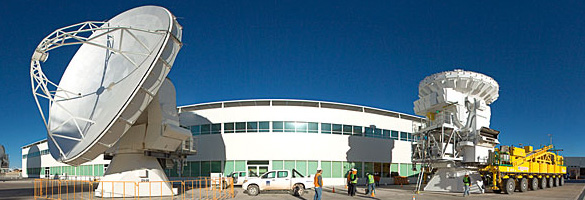Media Visits
ALMA is open to journalists and media crews interested in visiting its facilities in northern Chile either to produce news stories or documentaries, as long as this does not interfere with the observatory's regular operations. All visits must be coordinated in advance.
Because these visits imply a significant investment of ALMA resources, the observatory reserves the right to choose the projects it seems most beneficial in terms of disseminating information about ALMA, its partners and astronomy in general.
Lodging & Transportation
Safety Requirements
Main ALMA filming locations
Drone Policy
Lodging & Transportation
The closest town to the observatory is San Pedro de Atacama, which is the leading tourist attraction in Chile. The ALMA Operations Support Facility (OSF or ALMA camp) is located 40 minutes away from San Pedro, at 2,900 m above sea level.
We are unable to provide transportation or lodging at the OSF to members of the media. A list of hotels in San Pedro de Atacama may be found here.
Renting a vehicle is necessary to reach the OSF (4-wheel drive not required). Car rental options in Calama may be found here.
To travel from the ALMA camp or OSF (2,900 m) to the high-altitude site (AOS, 5,000 m), a Visitor Coordinator will drive you in an EPO vehicle, as a 4x4 vehicle equipped with an anti-roll bar is mandatory and drivers must be certified to drive at high altitude. The trip takes about 40 minutes.
Safety Requirements
Visits are preferably carried out in the mornings due to the climatic stability. Upon arrival at the ALMA site, media visitor(s) will be shown a safety video explaining the rules and procedures that must be followed. Media visitor will be accompanied at all times by a Visitor Coordinator who will obtain access to the facilities. Visitors must follow the Visitor Coordinator's instructions while at the site.
ALMA's high-altitude site (AOS or Chajnantor Plateau, 5,000 m) imposes some significant safety restrictions. Visitors are required to undergo a medical exam (checking blood pressure and blood oxygen levels) at the OSF (Operations Support Facility, 2,900 m). Those who do not pass the exam will not be allowed to continue to Chajnantor. Additionally, visitors must sign an acknowledgment and release form before being escorted to Chajnantor. Visitors allowed to visit the high site may only stay above 3,000 meters for a maximum of 2 hours. If more time is needed, all ALMA health requirements must be met. Detailed information about these requirements is here.
In order to work at 5,000 m (16,500 ft), it is recommended to prevent altitude symptoms by eating a light breakfast, avoiding stimulants such as coffee, tea, or cola drinks, as well as drinking enough water during the day. As for clothing, it is suggested to wear a parka, gloves, a hat with ear protection, windproof pants, sunglasses and sunscreen.
Main ALMA filming locations


Policy for using remotely piloted aircraft (drones) on the Chajnantor Plateau
Any request to use a remotely piloted aircraft, or drone, in the ALMA territories at the Chajnantor Plateau must comply with Chilean and foreign legislation. The drone must be duly certified with a manufacturer's serial number, must be manually operated, can’t exceed 9 kilos as maximum take-off weight and must have been manufactured or assembled from a factory kit that has operation instructions. The drone to be used in ALMA must have the necessary insurance to cover any damage or loss that it may suffer or cause to another person or property.
Transmissions are allowed only in the 2.4 GHz wi-fi band (the use of the 5.8 GHz wi-fi band is prohibited). The use of Bluetooth devices is not allowed at the Chajnantor Plateau (AOS), especially while the observation is being conducted, because they can interfere with it. The drone should not fly more than 20 kilometers per hour and the total flight time should not exceed 60 minutes. The use of drones will be authorized only when there are good weather conditions that allow visual control to be maintained at all times.
All documentation required for the use of drone in ALMA must be sent at least 30 days in advance. These devices can be used after approval of the ALMA technical team. For more details, request the drone policy at ALMA.